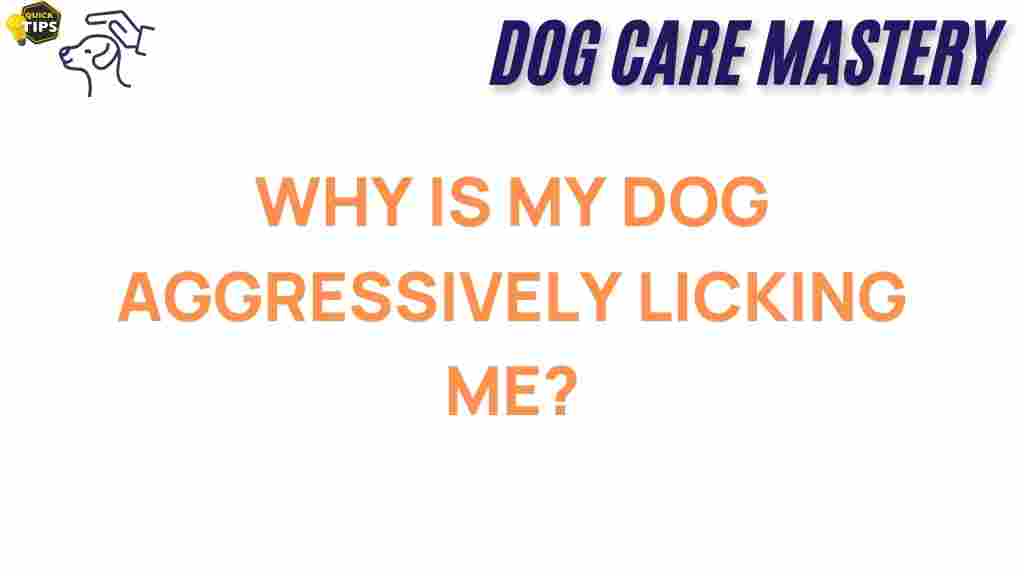Understanding Dog Behavior: Why Your Dog Aggressively Licks You
As dog owners, we often find ourselves puzzled by our furry friends’ behaviors. One of the most intriguing yet concerning actions is when dogs aggressively lick their owners. While licking is a natural behavior in dogs, excessive or aggressive licking can indicate deeper issues. In this article, we will explore the reasons behind this behavior, understand its implications, and offer tips for addressing it. By the end of this article, you’ll have a clearer understanding of your dog’s behavior and how to manage it effectively.
What Does Aggressive Licking Mean in Dog Behavior?
Aggressive licking can manifest in various ways, from incessant licking of your hands or face to more intense behaviors that may seem obsessive. To understand why your dog is displaying this behavior, it’s essential to consider several factors:
- Communication: Dogs use licking as a form of communication. They may lick to show submission, affection, or to seek attention.
- Grooming: Dogs groom themselves and others through licking. It’s a way of keeping clean and maintaining social bonds.
- Stress or Anxiety: Excessive licking can signify anxiety or stress. This behavior often manifests when a dog feels insecure or uncomfortable.
- Medical Issues: Sometimes, aggressive licking can be a sign of pain or discomfort due to an underlying medical condition.
Common Reasons Behind Aggressive Licking
Understanding the reasons behind your dog’s licking behavior is crucial for addressing the issue effectively. Here are some common explanations:
1. Affection and Bonding
Dogs often lick their owners as a sign of affection. In the wild, wolves lick each other to reinforce social bonds. If your dog licks you gently and intermittently, it could simply be expressing love.
2. Seeking Attention
If your dog notices that licking gets your attention, they may continue the behavior, whether it’s positive or negative attention. This is especially true if you respond by petting or talking to them.
3. Anxiety or Stress
Dogs can experience anxiety from various sources, such as loud noises, changes in their environment, or separation from their owners. If your dog’s licking is aggressive and persistent, it might be a coping mechanism for their stress.
4. Medical Issues
Sometimes, aggressive licking can indicate pain, allergies, or skin irritations. If your dog licks a specific area excessively, it could be worth consulting a veterinarian to rule out any health concerns.
Step-by-Step Process to Address Aggressive Licking
Now that we understand the reasons behind aggressive licking, let’s look at how to address this behavior effectively:
Step 1: Observe and Identify Triggers
Begin by observing your dog’s licking behavior. Take notes on:
- When does the licking occur?
- What situations or stimuli seem to trigger it?
- Is the licking focused on a particular area of your body?
Identifying triggers can help you determine whether the behavior is rooted in affection, anxiety, or a medical issue.
Step 2: Provide Positive Reinforcement
If your dog licks to seek attention, redirect the behavior by providing positive reinforcement for alternative actions. For example:
- Encourage them to sit or lie down instead of licking.
- Reward them with treats or affection when they exhibit calm behavior.
Over time, they will learn that calm behavior receives more rewards than licking.
Step 3: Create a Calm Environment
If anxiety is a potential cause, work on creating a more relaxed environment for your dog:
- Establish a routine to provide stability.
- Use calming aids such as anxiety wraps or pheromone diffusers.
- Engage in regular exercises to reduce stress and anxiety.
Step 4: Consult a Veterinarian
If aggressive licking persists despite your efforts, it’s essential to consult a veterinarian. They can:
- Conduct a full health assessment.
- Identify any underlying medical issues.
- Recommend appropriate treatments or behavioral therapies.
Troubleshooting Tips for Managing Aggressive Licking
Here are some additional tips to help manage aggressive licking behavior in dogs:
- Redirect Attention: When your dog starts licking, redirect their attention to a toy or another activity.
- Use Commands: Teach your dog commands like “leave it” or “enough” to curb unwanted licking.
- Increase Mental Stimulation: Boredom can lead to unwanted behaviors. Provide puzzle toys or engage in training sessions to keep your dog mentally stimulated.
- Limit Stressors: If certain situations trigger anxiety in your dog, try to minimize their exposure to these stressors.
Conclusion: Understanding Your Dog’s Behavior
Aggressive licking in dogs can be a complex behavior influenced by various factors, including affection, stress, or medical issues. By observing your dog’s behavior and identifying triggers, you can take steps to address the issue effectively. Remember that patience and consistency are key when modifying behavior. If the licking persists or worsens, don’t hesitate to seek professional help from a veterinarian or a certified dog trainer.
Understanding dog behavior can enhance your relationship with your furry friend and contribute to a happier, healthier life together. For more insights on dog behavior, consider checking out resources from The American Kennel Club or your local veterinary clinic.
This article is in the category Behavior and created by dogcaremastery Team
